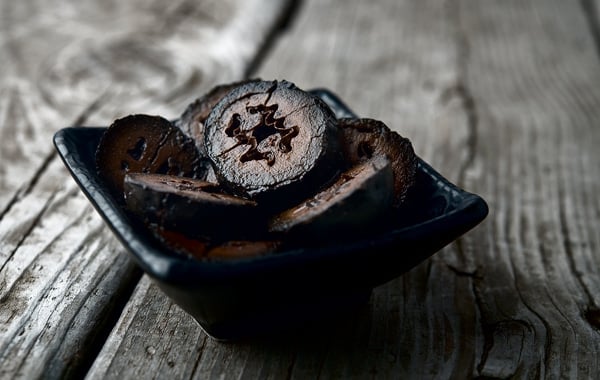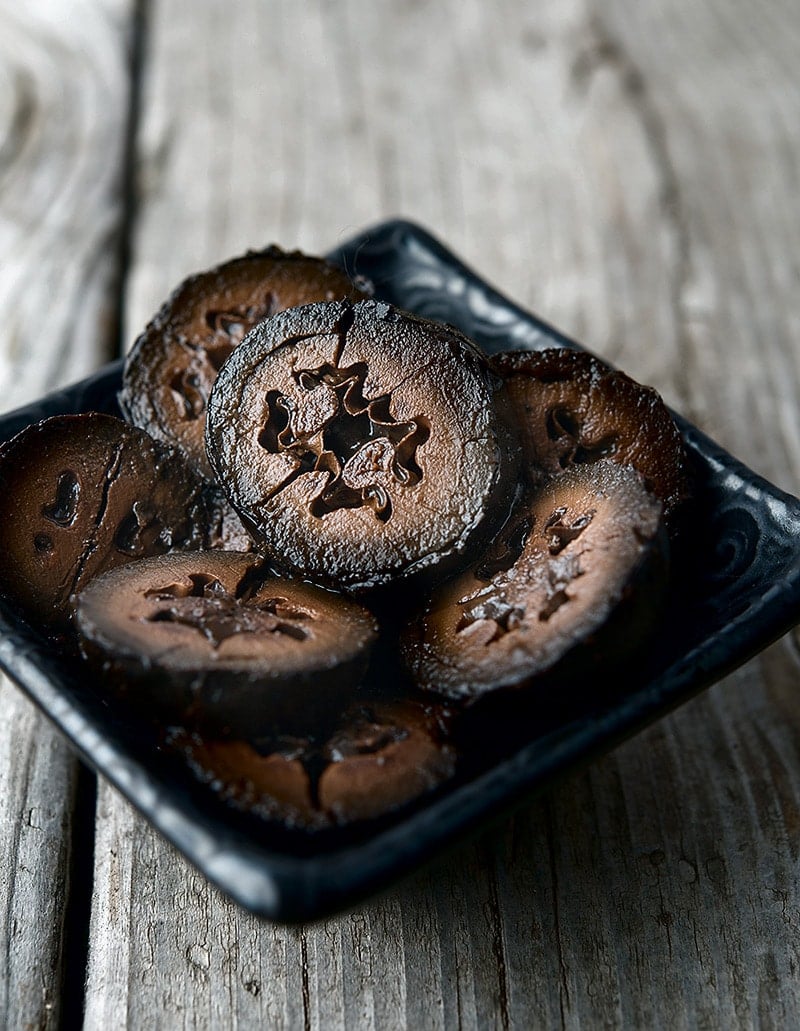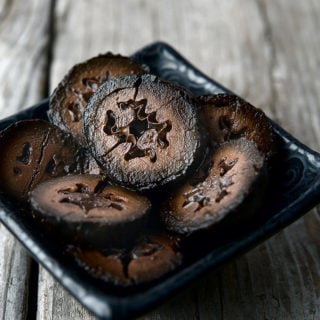As an Amazon Associate I earn from qualifying purchases.

There may be a few foods that are more English than pickled walnuts, but with the possible exception of fish and chips, I can’t think of one. Chances are, however, you’ve never heard of them. I hadn’t, until several years ago when I ordered the meat-and-cheese plate at a local Irish place called deVere’s.
On this place was a black disk. I asked the waitress what on earth it was, and she smiled; she’d had this question before: “It’s a pickled walnut. It’s good with the cheddar.”
I followed her advice and stabbed the disk with my fork, adding a bit of cheddar cheese and a bit of cold roast beef to round things out. Wow. It was a bit like eating solid steak sauce, with a little floral aroma and a zephyr of bitterness that just barely let you notice it.
I ate another disk all by itself: Fairly soft, puckery and strangely floral. And yes, there was definitely a Worcestershire-Heinz 57-A1-thing going on here. How had I never had these before?
Turns out that very, very few people outside of Britain eat them. This should change, which is why I am presenting you with this recipe. And the reason I am posting this now is because you need to get out and get your walnuts now. That’s right, you need green, unripe walnuts to make pickles. And yes, you use the whole thing, hull and all.

I got mine a few weeks ago, after an unsuccessful fishing trip with my friend Joe. We were in the Delta and as we were driving out, I noticed a NorCal black walnut (Juglans hindsii) absolutely laden down with nuts. “Pull over!” Joe, used to this by now, did. I gathered about 150 nuts in less than 15 minutes. It was a bonanza.
I knew I was in business right when I got to the tree, but just to be sure I pulled out my pocketknife and sliced an unripe nut in half. You need to do this, either with a knife or a stout needle or a long nail, because you have to catch the unripe walnuts before the shell forms. Once that shell forms inside the walnut’s hull, you’re too late; the traditional harvest date in England is late June.
The process for pickled walnuts is not hard at all, but it takes more than a week. You need to brine the green walnuts for a good long time before they will be ready to pickle properly. The brine time helps with preservation and removes some of the bitterness in the unripe walnuts. Once brine pickled, they are pretty durable.
Do you need to sun-blacken the walnuts? No, but doing so gives you a nice, uniform look to them. Otherwise they will be olive green in some places, blotchy black in others.

Once you have your pickled walnuts, what do you do with them? Look to the English. Traditionally they are part of a ploughman’s lunch, with other pickles, cheese and cold meats. But I see them a lot tossed into beef or lamb stews (pot pies and pasties, too!) in wintertime, and in summertime I’ve seen them served in cool salads alongside tomatoes, and accompanying shellfish such as scallops or shrimp.
Pickled Walnuts
Ingredients
- About 50 to 60 green, unripe walnuts
- 1/2 cup kosher salt
- 1/2 gallon water
- 2 quarts cider or malt vinegar
- 1 tablespoon cracked black pepper
- 1 tablespoon cracked allspice berries
- 1 ounce ginger, about 1 1/2-inch pieces, smashed
- 1 cup brown sugar
Instructions
- Dissolve the salt in the water to make a brine. Put on some rubber gloves if you have them, because walnut juice will stain your hands for weeks -- and it won't come off. Trust me on this one. Properly gloved, stab each walnut with a fork in several places; this helps the brine penetrate. Submerge the walnuts in the brine and let them ferment for 8 days at room temperature.
- Remove the walnuts and put them on a baking sheet and leave them outside in the sun for a day, until they turn uniformly black. You can do this step without gloves if you want.
- Pack the walnuts into quart jars. Bring the remaining ingredients to a boil and pour over the walnuts. Leave very little headspace in the jars. Seal and keep in a cool place, either the fridge or a basement -- you just want them to rest below 70°F -- for at least a month before you eat them. Kept this way they will last a year.
Notes
Nutrition
Nutrition information is automatically calculated, so should only be used as an approximation.






I just put the young walnuts in strong vinegar with loads of spices. All types and garlic. Leave for five years and they are fantastic. They keep forever.
Can you pickle White Walnuts?
The Pickled Walnuts are fantastic, the texture & flavour are superb.
The only down side, was I had made enough vinegar/spices for another batch, I will not make that mistake next year.
Hi Hank,
Sorry didn’t respond earlier about the CaCl addition. I found adding CaCl at the initial brining stage made them too firm to work with later – so it only gets added to the spiced vinegar at the end. Cheers -M
I made these a few times. I used a stronger brine and changed it after a few days. Some online recipes are way too salty and I have altered mine over the years… they keep for years, not just one year. Anyway, the main thing I was going to say was that I often put them in sandwiches and on pizzas, sliced up.
How do you seal the jars? Do you hot water bath or is there another method?
DeAnn: There is so much vinegar in there I didn’t officially seal them. I just shut the lids tight. But you could water-bath seal them for about 15-20 minutes to be safe.
I just found 5 walnuts that I could reach from the ground so they are brining in a pint jar. I had about 3,000 black walnuts last fall for cracking. about 1500 done and the last 1500 are sitting around until I used up the already cracked ones. Thanks for the recipe.
Picked 6 kg of green walnuts today will follow your recipe. I have a few friends who will be so so happy to receive a jar at Christmas.
Hi, ive just put mine in the brine. Am i right in reading that at no point in the process i half the walnuts? All the pictures show them cut in half, so i just want to make sure. Thanks!
Sarah: Yes, I rarely cut them in half until I serve them. But you can after they’ve gone black.
Hi Hank,
An update – last year I commented about Calcium Chloride. Happy to report this worked well.
I added a bit of CaCl both to the second exchange of brine, and a small amount to the spiced pickling vinegar itself. The result was good. No more mush.
M Harrison: Awesome! How much did you add? A teaspoon? More?
I made some of these 40 years ago and I still have a part of that batch and it is devine. I wonder if you can also pickle pecans and get a similar experience? I mention that since where i am in south texas i can’t find any immature walnuts but i can find pecans.
Thanks for the recipe and the back story. My dad made these all the time and now I am as well. Only addition to think about might be a few cloves for extra spice.
They appear clean cutted on the picture is it the pickling that makes them tender? Furthermore have you tried pickling with the spice mix for longer prior to putting them in jars ? Thank for the recipe, looking forward to it!
Iovan: Yes, they are tender — but these are made with unripe walnuts gathered in late spring, not mature ones.
Thanks so much Hank! I’ll look forward to making these next year. Your site is my favourite place on the internet when it comes to curing and preserving wild foods.
Can you use black walnuts to make these?
Sarah: That’s what I use. But you are too late in the year. These need to be made in June or July.
I use black walnuts from trees I grew from seed. Never wore gloves as the young nuts don’t exude much. I use coarse pickling salt not Kosher salt. It’s the exact same but costs less. I use smaller jars , we call them 500 ml.That way I can use the whole jar up in no time and don’t feel guilty giving a few away. Walnut trees don’t produce every year so best plant a few…it only take 15 to 20 years for them to produce.
Duncan: Weird. Our walnuts produce every year.
At what point do you slice the walnuts?
Drew: When you eat them.
could this be made without sugar, or does the sugar act as a preservative or fermentation fuel? and do the glass jars need to be sterilized? i lactoferment all the time without sterilizing equipment but don’t consider this a lactoferment. also, the vinegar is not acidic enough to inhibit botulism. is that a concern?–i made a batch of these last year, then discarded them without trying after reading other recipes that sterilized the jars and /or used a proper canning method. thanks for your thoughts!
Hi Hank,
I am on Vancouver Island, about to do a large harvest.
One complaint I have had about these is that even though the flavor is great, they are too soft. Do you know if these will benefit from the use of calcium chloride or another pickling agent to make them more firm?
Cheers.
M. Harrison: Yes, I’ve heard that a little calcium chloride can help. Not sure how much to add, though.
We live in Edmonton, Alberta and I don’t think our climate is compatible to growing walnuts. However, can anyone advise me as to where I may obtain green walnuts so we can pickle them?
We have never seen them for sale at any of the popular north American/Canadian grocery outlets.